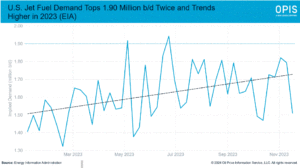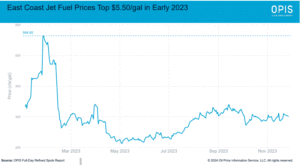US jet fuel demand in 2023 continued to recover from the COVID-19 pandemic, and the commercial airline industry began to move toward increased use of sustainable aviation fuel production to fulfill its net-zero carbon pledges.
 Jet fuel demand in 2023 peaked at 1.942 million b/d in June, followed closely by 1.917 million b/d in early May, the Energy Information Administration estimated.
Jet fuel demand in 2023 peaked at 1.942 million b/d in June, followed closely by 1.917 million b/d in early May, the Energy Information Administration estimated.
Those were the only two weeks of 2023 when jet fuel consumption reached the 1.9 million b/d mark, up from just one week when that number was reached or exceeded in 2022. In 2021 and 2020, jet fuel demand never reached that level.
That 1.9 million b/d-plus mark was much more common in the years leading up to the pandemic, with two weeks over that level and one week over 2 million b/d in late November and early December 2019.
Travel Expected to Continue to Increase
Demand is expected to continue to rise in 2024 as more travelers return. On the Sunday after Thanksgiving, the Transportation Security Administration reported more than 2.9 million passengers screened – a post-pandemic high.
The International Air Transport Association, which represents about 320 airlines responsible for 83% of global air traffic, has predicted the average cost of jet fuel in 2024 to be roughly $2.7095/gal. That’s up from the $2.6643/gal average it forecast for 2023.
Volatility in US Jet Fuel Market
US jet fuel prices in 2023 were volatile, particularly in the New York market, which experienced periodic supply issues.
 Jet fuel in the New York Harbor market from mid-January to mid-February was priced at a more than $2 premium to the front-month NYMEX ULSD contract. Spot market prices over that period rose above $5/gal for seven straight days and peaked at $5.6465/gal on Jan. 26 – the highest price of any US market in 2023.
Jet fuel in the New York Harbor market from mid-January to mid-February was priced at a more than $2 premium to the front-month NYMEX ULSD contract. Spot market prices over that period rose above $5/gal for seven straight days and peaked at $5.6465/gal on Jan. 26 – the highest price of any US market in 2023.
The spikes in New York prices came as stocks fell below 8,000 bbl, a level reached only 15 times since the start of 2019.
The early 2023 prices were similar to those seen in 2022, when New York area jet fuel prices topped $7/gal, a record high for the US.
While New York Harbor saw the biggest spikes of the year, other markets also saw price jumps in 2023. Midwest jet fuel early in 2023 was priced at $0.90 to $1 over futures, leaving the outright price at more than $4/gal for nearly two weeks in January. Jet fuel premiums to the NYMEX in Los Angeles rose to more than 50cts several times, with the spot price peaking at more than $4/gal in mid-September.
Those spikes, however, were short-lived, and the markets soon returned to more normal pricing patterns. From January to mid-December, OPIS jet fuel spot prices averaged $2.8277/gal across the five major jet fuel markets (New York, Gulf Coast, Group 3, Chicago and Los Angeles).
IATA expects global jet fuel demand to reach about 99 billion gal in 2024, or roughly 6.46 million gal/day. The International Energy Agency’s 2024 forecast is a bit higher at 7.19 million gal/day.
More airlines began using SAF in 2023 as a way to begin to meet their carbon-reduction targets, and production of the fuel is increasing, though it remains a fraction of conventional jet fuel output.
IATA estimated that SAF volumes in 2023 rose to 600 million liters globally, nearly twice the level in 2022, and accounted for 3% of total renewable fuel production. The industry group expects that to rise to nearly 1.9 billion liters in 2024, meeting about 0.53% of the aviation industry’s total demand. The increased use of SAF is predicted to raise the airline industry’s fuel costs next year by $2.4 billion, according to IATA.
Carbon Offsetting and Reduction Scheme for International Aviation
Most airlines have entered into the Carbon Offsetting and Reduction Scheme for International Aviation, or CORSIA agreement, which requires them to offset CO2 emissions above 2020 levels, and a number of carriers are testing blends of conventional jet fuel and SAF to help offset carbon emissions.
The production of SAF is expected to grow in terms of the piece of overall renewable fuels production as well. IATA expects SAF production to rise to 6% of total renewable fuel output in 2024.
Sustainable aviation fuel and renewable diesel don’t make as many headlines as other renewables, but they are critical to the transition away from fossil fuels.
Jordan Godwin, OPIS Director of Renewable Fuels, and Denton Cinquegrana, OPIS Chief Oil Analyst, examine the market and regulatory forces bringing these fuels front and center. Watch the excerpt of their conversation from Barron’s Live:
Passenger traffic totals at Los Angeles International Airport (LAX) in July 2023 reached 7.308 million, representing a 15.17% increase compared to the same period in 2022, according to the latest data released by Los Angeles World Airports, the owner-operator of LAX and Van Nuys Airport.
The U.S. produces roughly 1.5 million to 1.75 million barrels per day of jet fuel, and while that is much less than other distillate fuels (about 4.5 million to 5 million b/d) and gasoline (9.5 million to 10.5 million b/d) — it’s still a vital portion of the oil industry — as well as global travel and commerce.
The following is an excerpt from Americas: Oil Market Outlook 2023.
1 U.S. gasoline prices will again command the consumer stage but for different reasons than in 2022. A majority of U.S. retail numbers will commence 2023 below $3/gal and beyond a seasonal higher priced interval and those numbers may disappear by spring only to return later in the year. Diversity in state-by-state numbers will continue with perhaps $1.50/gal separating the lowest and highest priced states.
2 The 2022 OPIS/AAA average price for gasoline was within a fraction of $3.97/gal. A reasonable projection for 2023 calls for $3.39/gal to $3.49/gal. Relatively higher prices in western states and the Northeast will offset many of the sub-$3/gal prices in the Southeast, Midwest and along the Gulf Coast and in the Southwest. The gasoline “cut” for U.S. refiners will continue to be subordinate to diesel and jet fuel returns for most of the coming year.
3 Whereas 2022 U.S. average gas prices varied from about $3.099/gal to just over $5.015/gal, the fluctuations in 2023 will be much tighter. California will march to the tune of its own drum, with prices racing to $5-$6/gal levels during episodes of refinery downtime or other intervals of tight supply. Most lower 48 states will see availability of sub-$3/gal gasoline in various portions of 2023.
4 U.S. gasoline consumption in 2022 looks to be about 8.7 million to 8.8 million b/d when final numbers are rendered, or about 600,000 b/d below the ~9.3 million b/d figures that were the norm from 2016-2019. Cheaper prices are not likely to alter new commuting habits, and better mileage standards will keep consumption flat to 2022. So, OPIS expects annual demand of about 8.8 million b/d or about 365 million gallons per diem to continue. That projection takes into consideration a shallow recession or some lower employment numbers in the U.S. in the second half of the year.
 5 Thanks to the 2022 legacy, some dramatic price comparisons are likely. We suspect that between the middle of the first quarter of 2023 and the end of the second quarter, U.S. gasoline prices may be $1.50/gal or 30% below same week 2022 figures. This may present some of the most spectacular deflation across the commodity space.
5 Thanks to the 2022 legacy, some dramatic price comparisons are likely. We suspect that between the middle of the first quarter of 2023 and the end of the second quarter, U.S. gasoline prices may be $1.50/gal or 30% below same week 2022 figures. This may present some of the most spectacular deflation across the commodity space.
6 Diesel price strength will abate but diesel will continue to be considerably more expensive than gasoline, thanks to fuel switching (diesel for some purposes instead of natural gas in Europe and SE Asia) and low inventories. However, the anniversary of the Ukraine Invasion and paroxysms in 2022 diesel prices should bring deflation for this product as well. U.S. diesel prices peaked at $5.8159/gal in mid-June 2022 and much of 2023 should see diesel about $1.50/gal lower.
7 The 2022 average price for WTI came in around $94.50/bbl. We suspect that 2023 will see a price only slightly below this number with $90/bbl a reasonable prophecy for a 2023 annual average, with Brent commanding $95-$96/bbl. Precisely how high these numbers move above the average will depend on the successful reopening of China and the ability of western countries to avoid a significant recession. The lowest numbers for crude are most likely to be recorded in January and February.
8 Talk of global refining shortages will ease and perhaps abate by the second half of 2023. Huge new refining complexes in Africa, Southeast Asia, and the Middle East will restore comfort in the ability to create enough gasoline, diesel and jet fuel in international markets. With the notable exception of the lame duck Lyondell refinery in Houston (scheduled to close in late 2023) all U.S refineries should survive and even prosper. Refiners should see consistent domestic demand, some further growth in export activity, and a substantial advantage versus much of the world that comes thanks to much cheaper natural gas, electric, and hydrogen costs.
9 A real test for diesel and jet fuel arrives early in 2023 via the EU ban on Russian imports of diesel, jet fuel and gasoline. It will not be easy for European countries to be weaned from Russian dependency, particularly if Mother Nature brings cold temperatures in the Northern Hemisphere. U.S. futures’ markets might have a very dynamic first quarter since the Phillips 66 Bayway refinery — perhaps the most critical plant for CME futures’ delivery — goes down for 60 days in February and March.
10 Retail gasoline will continue to be a hot sector in 2023 although margins may slip from the off-the-charts’ levels of 2022. At least three major oil companies – BP, Shell and Motiva (owned by Aramco) — will pursue joint ventures or outright purchases of North American chain retailers. Brisk M&A activity will persist, although transaction multiples may dip with rack-to-retail margins.
As oil companies start to transition away from their fossil fuel businesses towards greener forms of energy, question marks surround their strategies.
Airlines are staring down a long road back in the wake of a veritable cliff dive in travel demand, which has led to an equally steep drop in the cost of jet fuel.
Strong demand and production remained trends for U.S. jet fuel prices in 2019, but as the calendar rolls to 2020, all eyes are on new IMO specifications, climate change initiatives and shifting fuel slates.
Read about where jet fuel prices started 2020 and where they are heading….
NOTE: Since the original publication of this blog, the new coronavirus sweeping China has curtailed air travel, as a slew of airlines halted flights, forcing refiners to cut runs and tweak yields to prevent a jet fuel glut amid a shrinking export market, industry sources said.
Estimates for the drop in jet fuel demand — the transportation fuel to bear the brunt of the virus outbreak that has led to the lockdown of over 40 million people in China — range from 300,000 barrels a day (b/d) to 400,000 b/d during the peak of the epidemic based on the 2003 SARS outbreak, they said.
Gasoline, diesel and jet fuel prices have been volatile in 2019. From political rhetoric to fundamentals, this year is shaping out to be a tumultuous one for oil markets.
For the past two years, consumption of jet fuel by U.S. airlines has been strong, meaning that the annual pace of the growth in jet fuel consumption has outdistanced its major transportation fuel components, gasoline and diesel fuel.
Will 2019 offer more of the same trend for jet fuel prices? Let’s find out.
